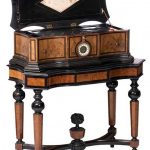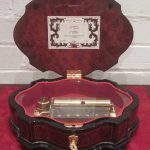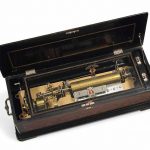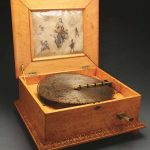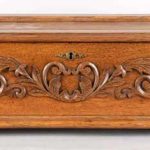Ebonising: Ebonising is a process for darkening wood, giving it an appearance similar to ebony, hence the name.
It is particularly used for pianos and fine furniture including music boxes. Reference: Wikipedia
Ebonizing wood is not the same thing as simply coloring wood with ebony stain. When you ebonize wood, you’re causing a chemical reaction that makes the material turn black. The benefit to this process is opacity. When wood is stained you can sometimes see the grain through the stain. When wood is correctly ebonized it becomes pitch black, and you won’t be able to see grain through the color. Reference: Woodworker’s Guild of America
Below are some examples of music boxes made from ebonised wood.
A fine burl walnut and ebonised wooden cylinder music box with orchestreon organ, ‘Fabrique de Geneve’, serial number 37089/9255, on a Baroque revival matching stand, H 103 – W 100 – D 54 cm
Sold for €23,000 at Carlo Bonte Auctions in 2019
A modern Swiss music box by Reuge Music bird’s eye maple, mahogany and ebonised case of cartouche form, mother of pearl inlaid floral detail, playing three airs, titled to inside lid, 27cm in width, 9cm in height.
Sold for £ 162 inc. premium at Bonham’s in 2013
A SWISS BURR MAPLE AND EBONISED WOOD INTERCHANGEABLE-CYLINDER MUSIC BOX LATE 19TH CENTURY The case with brass handles and bone escutcheon playing one cylinder with six airs, and with two further interchangeable cylinders, with zither attachment 30 ½ in. (77.5 cm.) wide
Sold for GBP 2,250 at Christie’s in 2014
